I have to say, this period of British (art) history (1860-1900) fascinates me. As it’s the V&A, the exhibition covers more than art, looking at fashion, design, textiles, furniture making, sculpture, literature… So, the Aesthetic movement covered a far broader spectrum than my keen interest in the Pre-Raphaelite artists and I’m pleased to say I learnt quite a lot of new stuff.
This covers a period of time when the artistic elite all knew each other, literary giants rubbed shoulders with artists, musicians, actors and royalty. Would our current celebrities ripple through time like this bunch? Probably not! I doubt the V&A will host a “big brother/WAG/footballer” extravaganza in 150 years.
Scratch below the surface of supposed respectable Victorian society and layers and layers of decadence and self indulgence unfurled themselves. London however, was probably not a nice place to live back then. The Thames stank of human sewage, thousands of girls worked the streets, poverty and disease were rife, people doffed their caps and said “evenin’ mister, spare a farthing?”. And the “cure all” prescribed for most ailments was “Laudanum”, an opiate which got you soporifically smacked out your nut and by all accounts was very addictive too.
On entering the exhibition, a very small, understated portrait of Lizzie Siddal, painted by her husband Dante Gabriel Rossetti, a prominent member of the Pre-Raphaelite brotherhood. Red hair, back then, as now, was not seen as conventionally beautiful, but Rosetti captured it and her melancholy poise, wonderfully in this portrait. She is stunning (“stunner” was a word the Pre-Raphaelites allegedly invented for the young lassies that caught their eye).
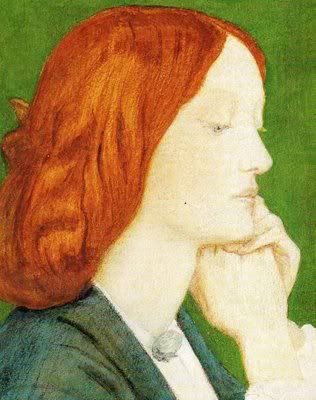
She was one of the super models of her day, most famous for being the model used by Millais for his Ophelia (a painting not included in this collection, but can be seen at the National Gallery). This painting is just achingly beautiful in my opinion. In a recent Millais touring exhibition, this painting was used as the publicity poster, apart from in Japan, where it was thought too dangerous, in case young girls would kill themselves at seeing such a tragic scene.
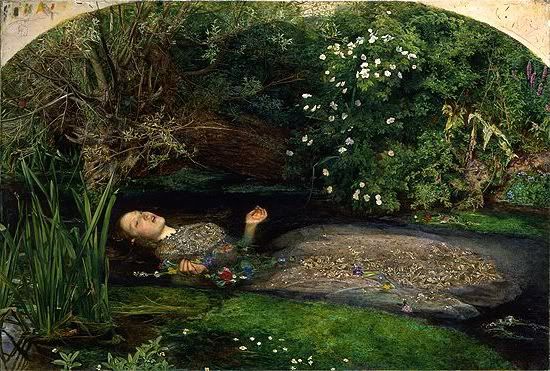
Detail

Following several affairs, including one with the wife of one of his loyal friends, the designer William Morris, Rossetti eventually married his long time, long suffering love. Her health was poor, from Laudanum abuse and at her death, the genuinely distraught Rossetti did write several poems for his dead wife and arranged for them to be buried with her. Upon realising he might make money from these poems, he had his wife exhumed… to retrieve them!
Which brings us onto Exhibit 2, Dante’s sister, Christina Rossetti. She wrote a long poem called “Goblin Market”, the first edition is exhibited here. Even reading it today, it conjures up quite vivid images of violence, sexual ambiguity and drug abuse. I’m surprised she got it published back then! Interestingly one of her main characters is called Lizzie, perhaps a nod in the direction of her future sister in law Siddal.
The story concerns two sisters and another girl as well as some abusive goblins trying to sell their addictive “fruits” to them. I wont go into much detail, suffice to say it’s quite disturbing at times, especially the violence. The sexual metaphors also range from the subtle to downright racy. When combined with the violence, it’s pretty hard hitting.
Unlike her brother, Christina never married or seemed to lead a life beyond writing, devotion to the church and charity. But her work… whoa! Extract from Goblin Market -
She cried "Laura," up the garden,
"Did you miss me ?
Come and kiss me.
Never mind my bruises,
Hug me, kiss me, suck my juices
Squeezed from goblin fruits for you,
Goblin pulp and goblin dew.
Eat me, drink me, love me;
Laura, make much of me:
For your sake I have braved the glen
And had to do with goblin merchant men
And the cover art of the book (by her brother Dante of course) is quite suggestive too.
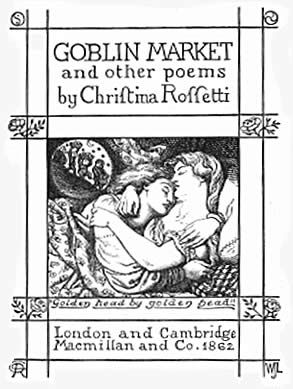
And if we are talking of controversial poetry, then let us not forget Algernon Charles Swinburne (mentioned in my blog about Suffolk), the wild child poet, who is also represented in the exhibition. His poetry collection “Poems and Ballads” was attacked for its pagan sentiments, sado-masochistic themes and overtly sexual nature (including some in homage to Sappho of Lesbos). He was an atheist and a republican. Bit of a geezer really. Although, he may not have indulged in vice as much as his poetry built him up to. As Oscar Wilde said of him : “A braggart in matters of vice, who had done everything he could to convince his fellow citizens of his homosexuality and bestiality without being in the slightest degree a homosexual or a bestialiser.”
I’m missing out great chunks of the exhibition of course, but next on my list of interesting items is William Morris’ only known painting. It is of his wife Jane Burden (Morris).
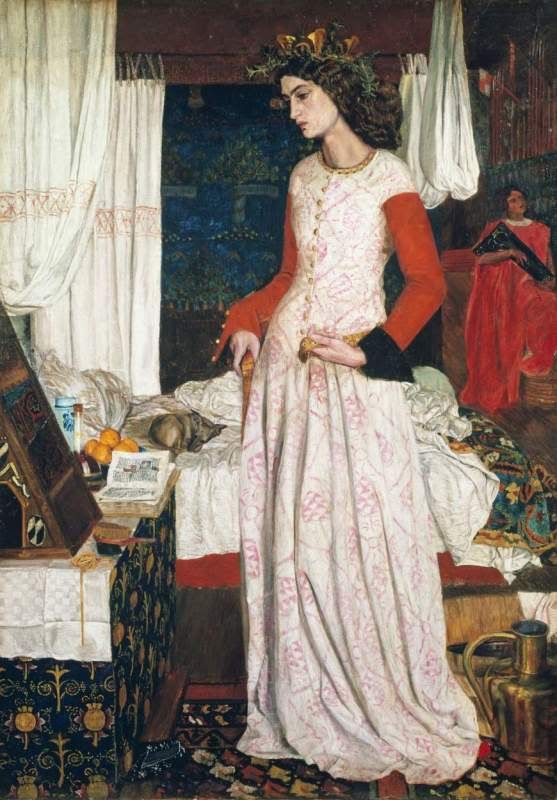
Morris was a designer by trade of course. His wallpaper designs are of course incredible (in the detail of the painting you can see some design elements too, on the dress, in the furnishings), so he didn’t feel up to trying his hand at art, but encouraged by Dante Rossetti he created this beautiful painting. Rossetti then had an affair with his wife after inviting her to model for him. Interestingly her wikipedia entry says their relationship was purely platonic. I wasn’t there of course, but I would like to say BOLLOCKS! They were at it. Fo’sure.
The next work of art is by Burne-Jones, another of the Pre-Raphaelite brotherhood. I have no anecdote to add for this one, other than the scale is huge and the detail incredible. It’s a lovely painting. Out of the big three original Pre-Raphaelites, Millais, Rosetti and Burne-Jones I would say the latter had the most consistently beautiful output. It is a painting of Merlin being beguiled.
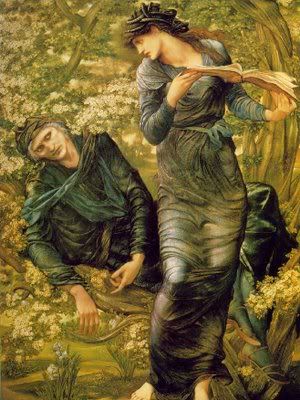
Next on the list, James Abbott McNeill Whistler. I wasn’t really aware of his work previously, so I was really pleased to see such depth of quality and style. He was a forerunner of the concept of the “installation”. He took great care to hang his own exhibitions, to make the most of space and environment. Artists prior to that just left it to the gallery to sort out, so he was ahead of his time.
Three very different works exhibited (amongst others) -
Symphony in White No 1: The White Girl
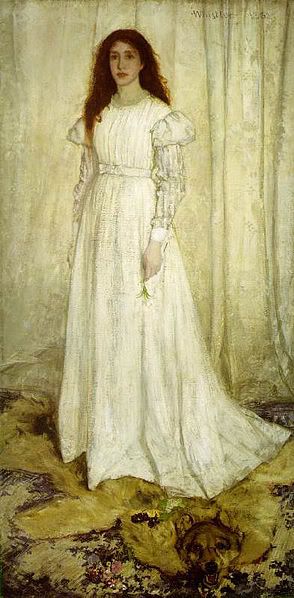
Some amazing detailed etchings of the Thames, incredible. Here’s one example.
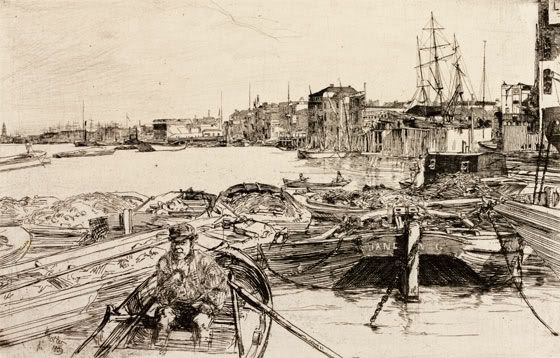
And another work from the Thames, which gives it an eerie foggy look.
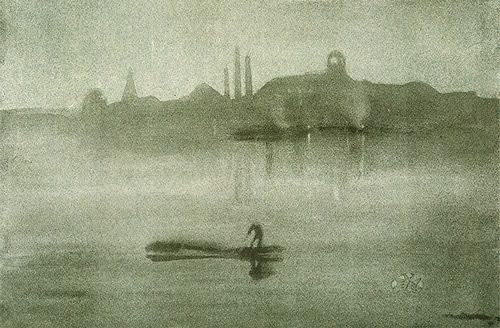
Whistler is cool, I’ve decided.
The shame was that John Ruskin, the eminent art critic, poet and social thinker, took offence to his work. In much more erudite terms he basically said Whistler was shit. How dare he try to copy Turner and include filthy cockney’s in his work was the nub of it. So Whistler sued him for libel. Now John Ruskin was a long time friend of Rossetti and was also Siddal’s patron. His wife had also left him… for Millais. They were all shagging each other, apart from Ruskin who had shagged no one. It seemed he was a lovely man, but unable to consummate his marriage. But enough about shagging, Whistler took him to court… and won. A farthing! (1/4 of a penny in modern terms). It was a symbolic victory as having to pay half the court costs bankrupted Whistler. He had to start again.
I mentioned Oscar Wilde earlier, something I’d never heard of before (but I’m going to buy a modern reprint with original art if at all possible) is his collection of children’s stories “The Happy Prince”, illustrated by Walter Crane. I’ve never tried to read Wilde before, I’m only 40 after all :)
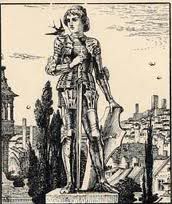
So I think I’ll start with this collection of stories, the first edition is tantalising open on the first page in the exhibition, made me want to punch through the glass and flick on to the next page!
High above the city, on a tall column, stood the statue of the Happy Prince. He was gilded all over with thin leaves of fine gold, for eyes he had two bright sapphires, and a large red ruby glowed on his sword-hilt.
He was very much admired indeed. ‘He is as beautiful as a weathercock,’ remarked one of the Town Councillors who wished to gain a reputation for having artistic tastes; ‘only not quite so useful,’ he added, fearing lest people should think him unpractical, which he really was not.
‘Why can’t you be like the Happy Prince?’ asked a sensible mother of her little boy who was crying for the moon. ‘The Happy Prince never dreams of crying for anything.’
‘I am glad there is some one in the world who is quite happy,’ muttered a disappointed man as he gazed at the wonderful statue.
‘He looks just like an angel,’ said the Charity Children as they came out of the cathedral in their bright scarlet cloaks, and their clean white pinafores.
‘How do you know?’ said the Mathematical Master, ‘you have never seen one.’
‘Ah! but we have, in our dreams,’ answered the children; and the Mathematical Master frowned and looked very severe, for he did not approve of children dreaming.
The Cult of Beauty is on at the V&A until 17th July. Check it!
2 comments:
Enlightening and enthralling, and that's just this post! More more! The Japs had a point, I'm sure there's a DVD series of Goblin Market, or was it Gobbling, perhaps. And are you sure all of this wasn't taking place in Stevenage Old Town?
I've been meaning to go to this ever since I heard about it, so it's really nice to see it from your eyes Mel. I like the Goblin Market : )I've got it in a tiny book all on it's own. I used to dip into it when I was out and about..x
Post a Comment